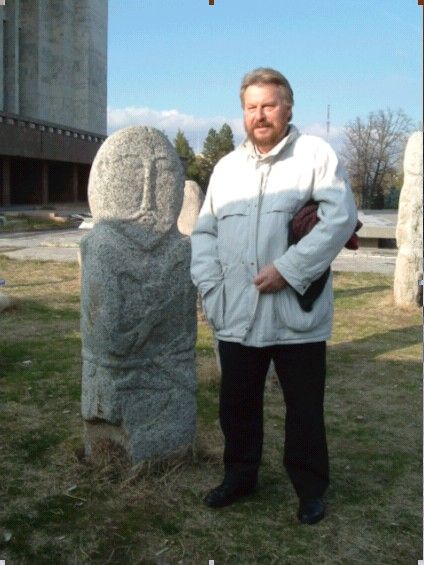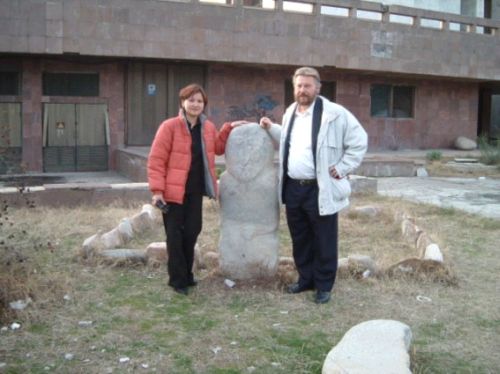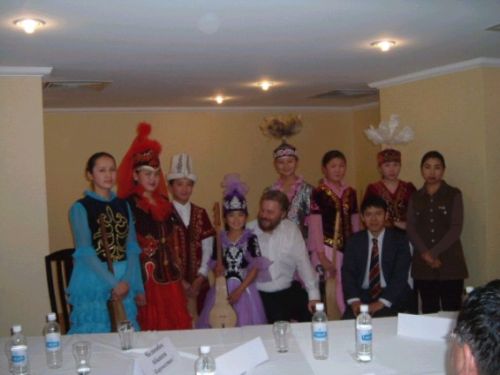Religious Revival and Identity in Modern Kirghistan
Wolfgang-E. Scharlipp
Copenhagen
(Dieser Beitrag erscheint auch im "Central Asiatic Journal" 49 (2004) 2)
Kirghistan declared itself independent on the 31st of August 1991, on the same
date as Uzbekistan. Kazakhstan followed a few months later, on the 8th December.
This slight hesitation on the side of Kazakhstan can be interpreted as an
indicator for the closer connection that this country had to Russia compared
to the other Turkish republics. The new republics faced all the problems that
new countries have to deal with. Problems include among others, building up an
independent economical and monetary system, introducing a new constitution and
legal system, and last but not least, a modified educational system.
The ex-member states of the Soviet Union faced some more big problems which
remained to be solved. Their traditional culture had come under Russian
influence and partly disappeared. Two of the most important cultural factors,
language and writing systems had to be reformed. In all Turkish republics
language reforms are being carried out, which also include the creation of
scientific terminology, as until recently Russian had been the language of
science. Seeing at least a certain Westernization as the prerequisite for
modernization, the Cyrillic alphabet was given up and the Latin alphabet
introduced instead, by Azerbayjan 1991, Türkmenistan 1993, Uzbekistan 1993,
reformed alphabet 1995, Tatarstan 1999. Kazakhstan announced to introduce
the Latin alphabet in the future, while at the same time continuing also to
use Cyrillic, Kirghistan so far does not intend to introduce a Latin based
alphabet. This fact reflects the search for identity, which is the topic of
our article.
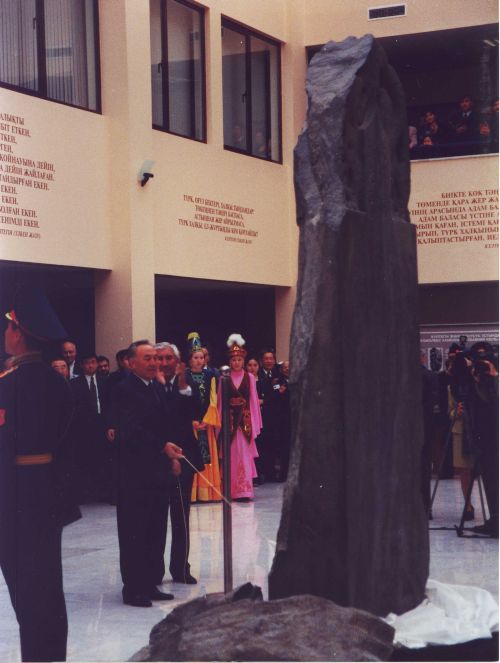
President Nazarbayev inaugurates the Köl Tegin Stone
I
On the 18th of May 2001 a copy of the stele of the Turkish prince Köl Tegin
(erected 1st of August 732 in the Mongolian steppe), was inaugurated in the
hall of the university of Astana, the new capital of Kazakhstan. The
inauguration festivities were headed by Nursultan Nazarbayev, the president
of the state. The festivities were accompanied by a symposium about the Old
Turkish Orkhon inscriptions, which are written in a writing system, that was
obviously developed especially for writing Turkish. Because its letters have
shapes very similar to the Germanic runes, they were called
"Old Turkish Runes", a term now criticized by some Turkish nationalists.
One of the speakers of the opening session was the author of these lines,
who was invited in his capacity as the "successor" of Vilhelm Thomsen, the
Danish linguist and decipherer of the Turkish Runic alphabet. (It should be
added here that not only the Institute of Central Asian Studies at this
university was closed down ca. twenty years ago, but that even the field of
turkology is only in an experimental state and might also be closed soon.
Furthermore the reader should know that all of Central Asia, as well as the
study of pre-Islamic Turkish language and culture is regarded as being
something outdated and superfluous in accordance with the local idea of
"modernism".)
The papers read during this symposium were published shortly after in the
form of a book, the quality of which is of a high standart, with a hard cover
binding, good inside paper, and photos of the speakers in the panel. The cover
is decorated with all the signs of the Runic alphabet, the title is printed
in Kazakh, Russian and English (see literature: Proceedings…2001) All the
papers included treat various aspects of the Old Turkish Runic inscriptions
and the book is hitherto the greatest collection of articles on this topic.
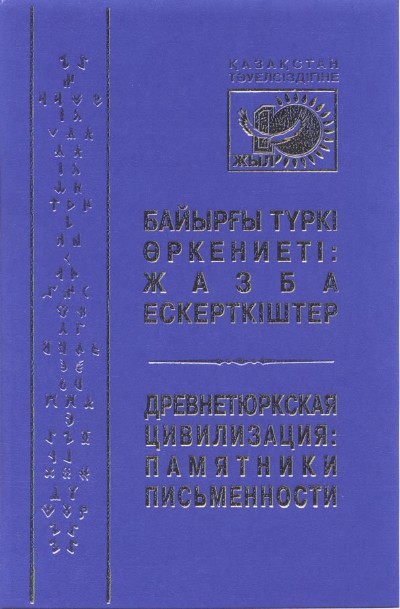
Proceedings of the Conference in Astana
Shortly before, in May 2001, another book had been published on the occasion
of the 10th anniversary of the independence of Kazakhstan, dedicated to the
Old Turkish Orkhon inscriptions (see literature: Orhonskie nadpisi). It
includes various articles concerning the three big inscriptions of Mongolia,
containing reprints of old contributions of P. Melioransky, V. Radloff,
S. Malov, S, Amanžolov, J. Stebleva, M. Auezov and A. Amanžolov's essay about
the origin of the Old Turkish Runic letters. In the beginning of the book we
find a preface written by president Nursultan Nazarbayev and a short
introduction written by the rector of the "Eurasian University" in Astana,
Mirzatay Žoldasbekov, both in the Russian and Kazakh languages.
In 1999 a meeting of turkologists took place at Frankfurt University to which
Marcel Erdal had invited and where a possible new writing system for Kazakh
was discussed. The Cyrillic alphabet was to be replaced by an alphabet that
should contribute to finding a new identity. For such an introduction of a
new alphabet often the reason is given that a writing system should be
introduced which is more efficient in giving the sound system of the respective
language than the alphabet used at the present time. The change from the Arabic
alphabet to the Latin alphabet in Turkey in 1928 is an excellent example for
the political background of introducing a new alphabet. Introducing the Latin
alphabet for Turkish was the strongest visible signal of changing from the
cultural basis of the Islamic Ottoman Empire towards a modern democracy in the
Western sense.
In a culture in which the written word enjoys a particularly high prestige,
the system of writing enjoys a particularly high symbolic value. It is thus
not surprising that among the Kazakh participants of the meeting in Frankfurt,
one seriously argued in favour of introducing the Old Turkish Runic alphabet
in order to replace the Cyrillic one. This proposal was based on the argument
that the Runic writing system would clearly indicate the Turkish past of the
Kazakhs, making clear at the same time the self-identification with an
autochthonous cultural achievement.
Such effects of the search for identity are often belittled and ridiculed by
societies who are not familiar with this kind of problems. In this respect I
would like to remind in the fact that all societies take advantage of their
most remote past in order to prove the age of their cultural achievements.
As our topic are Runic inscriptions, a good example - and we only need one - is
a book like "Dansk litteratur fra Runer til grafitti" (Danish literature from
runes to graffiti), which is one of the most common Danish introductions into
Danish literature and not only has the word "Runes" in the title, but includes
also an illustration of the short Runic inscription of King Harald from ca 970.
II
In an article published 1998 I had drawn attention to the role that the
knowledge of and about the Old Turkish Runic Inscriptions had played among
Turkish intellectuals at the end of the Ottoman Empire and the first years of
the Turkish Republic. The decipherment of the Runic alphabet and the sudden
awareness of an original Turkish, non-Islamic, non-Buddhist historical cultural
past with its autochthonous, written sources had contributed to developing a
national identity that could be constructed without the help of Islamic
culture.
The circumstances and conditions for constructing a Kazakh national identity
are similar only to a certain degree. As was the society of the Ottoman Empire,
also the society of Kazakhstan is multiethnic and multireligious. But religion
never had the same importance and power in Kazakhstan. The necessity to
strengthen a Kazakh nationalism was rather conditioned by the fact that Kazakhs
are a minority in their own country, 39.7 % of the total population in 1989
(Mangott, p. 32).
The "kazakhization" of the country, which has been pushed forward by president
Nazarbayev, was mainly directed against the danger of Russian dominance or at
least too high demands from the side of the Russian population of Kazakhstan,
being only slightly less than the Kazakh population (37.8 % in 1989). Most
actions taken in order to demonstrate Kazakh dominance in the state have mostly
been symbolic. A clear example for this is the fact that former Akmola,
situated in the Russian dominated North of the country was made capital
(now called Astana), instead of the old capital Almaty, situated in the South
Eastern corner near the borders to China and Kirghistan.
III
Turkish states, whichever we think of, are in publications usually referred
to as "Muslim" countries. Almost every author who writes about Turkey feels
obliged to mention that 99% of the population of Turkey are Muslims. In this
tradition an otherwise thoroughly written study of the modern Central Asian
countries gives the percentage of Muslims of the total population of Kirghistan
with 72.This number corresponds roughly with the non-Russian population of the
country.
Visitors to Bishkek, the capital, will look in vain for anything that indicates
the presence of Islam. The town makes a very Western - if this word is allowed
here - impression, although the poor economy prevents sometimes the impression
of "modernity". It is certainly legitimate to say - and for the sake of truth,
we may get a bit polemic - that most bigger cities of the "Muslim" Turkish
states give a more Western or modern impression than most big cities in North
and South America with their slums. Nevertheless Islam is present in the
country, although it does not show in the capital. It is found mainly in the
South and in the country side. Even if Islam here is on the rise, according to
Mangott (p. 3), an impact of religion on the town population and especially on
intellectuals, cannot be stated. Islam does in these parts of the society not
play a role as a factor of self-identity.
From the 9th to the 12th of November 2003 the public foundation "Tengir Ordo"
hosted an international congress titled "Tengirçilik is the world view of the
Altaic people". The singular form "people" might not indicate the idea that
all ethnic group speaking an Altaic language are regarded to be one people.
It rather might indicate the idea of a group of persons being united by the
same cultural past. It might furthermore indicate a certain unfamiliarity with the English language.
This unfamiliarity can also be seen in the few English
papers which were handed in for publication in the conference acts.
Furthermore only few of the papers read during the conference could be regarded
as scientific in an international sense. Although some of the papers were
nevertheless interesting, what counts even more is the fact that such a
congress could be held. Besides this, it is especially the less scientific
papers, being partly rather emotional, which made clear why such a congress
had to take place according to the opinion of the participants. We will come
back to this further down.
In the focus of this congress were the religious or philosophical aspects of
the Old Turkish nomadic empires. We will give here a very short summary of
what in so far has been accepted by Western science of the scarce knowledge
we have of what some call "tengriism" or "tengrianity" as it is called in the
title mentioned above.
The highest god is the divine sky, which is called "tengri". This word seems
to designate the visible sky as well as its divine character. Trying to define
the "tengri" from what is said about it in the Old Turkish inscriptions, is
impossible, as neither its character nor its relation to the other divine
powers become clear. Quality and abilities of this divine power have been
investigated by several scientists, but their conclusions differ in certain
aspects from another. One big problem is , in how far "tengri" himself is a
creator or is he created himself? The other unanswered question is, in how
far can he be regarded as the only god, a question the answer of which depends
on whether "tengri´s" relation to other divine powers has to be understood.
The inscriptions mention "umay", who is feminine and who could, in the opinion
of some researchers be identical with the goddess of earth. But the
inscriptions mention also the word for earth, "yer" in close connection with
"sub" water. In these cases we certainly have to understand certain locations
and lakes and rivers, which were sacred places and to which sacrifices were
made. We can furthermore understand from the inscriptions that "tengri" could
interfere into the life on earth. We read that the "kaghan" the emperor,
could loose his power to govern his state, if he was unable to keep up
stability and equilibrium among his people. It was especially the unclear
relation between "tengri" and "umay" which caused a discussion among scholars,
in how far we are faced with a monotheistic religion in the case of
tengrianity.
The role that shamanism and totemism played in relation to the religion of
tengrianity has been discussed by several scholars, but will not be considered
here, as it was no topic during the congress. (to this topic see: Roux 19 and Scharlipp 1991)
During this congress the inscriptions played a role only in so far as they
could possibly contribute to our knowledge about this religion. When there
was from time to time a reference to the old stone inscriptions, speakers
mostly referred to the inscriptions found in the Yenissey basin as "Kirghiz"
inscriptions, which is in accordance with the international scientific opinion.
Mentioning the stones of the Mongolian steppe, these were referred to as
Old Turkish.
The Old Turkish inscriptions became an object of academic research and
publication in Kirghistan a little bit later than in Kazakhstan (and several
years later than in Azerbayjan; see list of literature). Two Kirghiz
turkologists were - to my knowledge - the first Turkic scientists to write an
introduction into the Runic inscriptions in a Turkic language, the main part
of their book being a grammar and a glossary written in original Runic signs
together with a Cyrillic transliteration and a Kirghiz translation.
The authors K. Konkobaev and S. Sydykov are professors at the "Kirghistan/Turkey-Manas
University" in Bishkek. This university was founded by both countries,
Kirghistan and Turkey, the contract being signed 1995 in Izmir/Turkey. Kirghiz
and Turkish are both languages of instruction. The study program of Turkology
at this university offers a thorough education in Turkish philology in the
classical sense, including two semesters reading Runic inscriptions, continuing
with classical Islamic texts of Central Asian Turkish (Karahanic and Chaghatay),
continuing with Ottoman, modern Kirghiz and Modern Turkish.
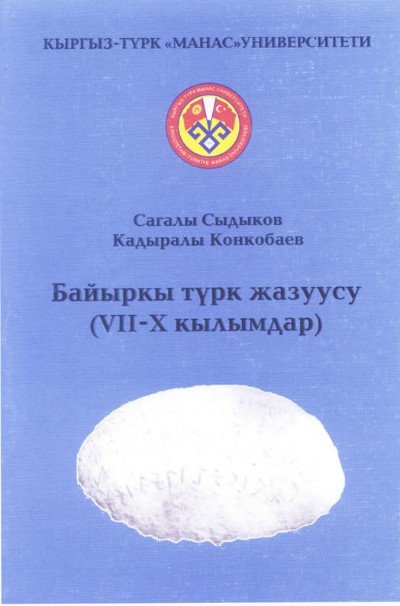
Introduction into the Runic Inscriptions by Sydykov and Konkobaev
During the conference the inscriptions were only in so far of importance as
they allow some conclusions referring to the beliefs of the Turks of the
steppe empires. But only one paper concerned the role of "tengri" as it
appears in several places in the Yenisey inscriptions (Takashi Osawa: "Aspects
of the cult and culture of Tengri on the ancient Turkic inscriptions of the
Yenisei Basin"), one paper treated the role of tengri in an epic poem (Aigerim
Dyikanbaeva: "Kococaę Destanında Tanrı Kavramı"). A third paper tried to
summarize the results to which Western scientists had come concerning the
"cult of heaven", including the role of the earth and the "sacred places".
The other papers focused on the conception of tengrianity, discussing mostly
how these conceptions should be understood, whether it can be regarded as a
religion or rather as philosophy. In the context of these discussions the
similarity and possible historical relations with religions and world-views
of other societies were also a topic of several speakers.
In the following I quote a passage from a paper titled "Religion or philosophic
outlook" by G. Akmatova, M. Murataliev and N. Esengulova, which gives both, a
clear picture of how the speakers presented their papers and some typical
topics, which will shortly be discussed at the end of the quotation.
"We understand religion as a form of social consciousness that includes
spiritual notions based on the belief in the existence of God, but assumes
mandatory forms of behaviour and specific actions (cults, riddles), in
churches, mosques etc.
Tengreanism from the point of view of theologists who are based on religious
dogmas is the connection between two beginnings: the Sky and the Earth, Good
and Evil, Light and Darkness (all spelled with capital letters, W.E.S.). The
followers of Tengreanism consider the Sky as the omnipotent force of Divine
Goodness and Light, Beginning of all Beginnings, Eternity. The Earth and the
Sky were inseparable. Man appeared as the link between the Sky and the Earth
whose good intentions and deeds were strengthening the connection, giving
birth to harmony and wellbeing on the Earth. Bad intentions, in the opposite,
could ruin the connection and provoke chaos and panic on the Earth.
The Sky was considered as the one and only source of the Divine Grace and was
steadfast. Man perceived the Sky as the criteria for clear consciousness,
moral criteria. The Sky could punish or bless. In the interpretation of
Tengrean researchers the Sky was omnipresent and an omni-inclusive substance.
Therefore all the ancient nations believed in the power of the Sky and
worshipped it as the God itself.
We hypothesize that Tengreanism should be considered as the philosophic
world view that is common for different cultures, which developed moral and
ethic values despite geographic and religious borders. The essence of
Tengreanism, as we see it, embraces the idea of achieving harmony through the
understanding of connectedness between Nature and Human Beings.
Man achieves a spiritual revelation, as it applies to God, by taking the way
of self perfection, embracing life and keeping the balance with nature. Ancient
peoples of the Altai, including the Kirghiz people, cherished their land. They
considered land a life-giving force of everything existing and hence sacred.
Out of this belief different rituals were born, connected to the sacrifices of
the Earth (Jer/Suu/Tauuy). Special attitudes towards Earth resulted in harmonic
coexistence with the environment of rational use of natural resources.
It is worth mentioning that Man never valued himself above Nature (surrounding
spiritual and material world) and never considered himself the master of the
Earth as certain concepts tried to present it based on the ides that Man was
the most evolutionally developed creature on the Earth, and Nature existed to
satisfy his needs. On the contrary, in tengreanism Man is trying to live in
harmony with the surrounding world keeping the balance and considering himself
as one wholesome creation with Nature where one cannot exist without the other.
Moreover Man understands that the damage to the environment will ruin the
divinity of life, because Nature is a God creation as well. Tengreanism and
the idea of harmony and equality with Nature were born, as we think, at the
moment when human beings appeared and represented the very first world outlook
for humanity."
There are several points in this section which it has in common with most of
the other papers. Tengreanism is understood as a world view based on a
dualistic principle. Several papers underlined the similarity between this
old Altaic world view, Zoroatrism, but more than any other ideology, Taoism
with its Yin and Yang principle. Some speakers expressed the original identity
of Tengreanity and Taoism and in some cases also Shintoism was included.
Based on the idealization of the equilibrium of two cardinal powers as
symbolized in Yin Yang, some speakers focused on the importance of this
equilibrium for ecological thinking.
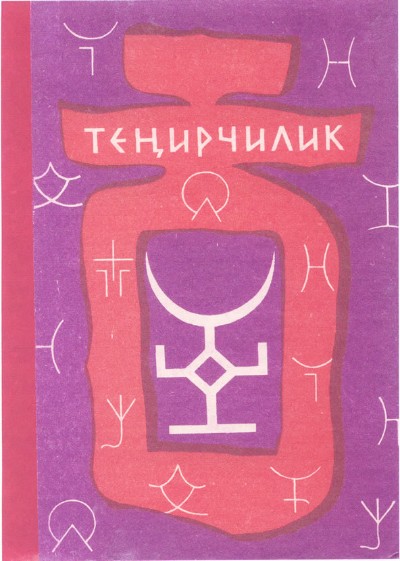
Book about Tengirçilik by Choyon Ömüraliev
The title is written in Cyrillic letters which are given the shape of runes.
S. Sarygulov, who had organized the congress, had particularly stressed this
point in his opening speech. He sees tengrianity as an alternative to the
many -isms which so far acted as social principles of mankind, leading to
nothing but conflicts and ecological catastrophies :"This is the first time
in the history of humanity that nature……became the crucial and defining
factor in mankind´s fate (the "hotbed effect" ozone hole, lack of natural
resources, total water, soil, atmosphere pollution, lack of drinking
water etc.)".
Although at no time during the conference anything positive about communism
was mentioned, one is well aware of the destructive effects of capitalism as
it is flourishing now: "The domination of capitalist ideology, not combining
with morality, in tandem with the scientific-technical revolution, lead to an
increasing dehumanization phenomenon of humanity, its spiritual and moral
degradation having become the plague of amorality, rapidly spreading all over
the planet." Sarygulovs opening speech focused thus on many global issues,
which the predominant ideologies were not able to deal with appropriately or
which they even caused to increase.
Tengrianity as a contribution to constructing or intensifying an already
existing national identity, did not play the prevailing role one could have
expected, but was mentioned by some speakers. We quote one example from the
paper of Nurgul Osmanova: "For the Kyrgyz society the problem of
self-consciousness and finding the place in the varied technocratic world is
one of the most crucial questions. The reason for that is that in this
transitional period, the process of internationalization, globalization of
modern life and culture and mankind´s way of thinking, do not always have
positive effects on the culture of our people. Because culture is connected
with imposing so-called "Western" and "American" way of life-style and mode
of thinking on moral and cultural values of our own society. This process of
accustoming with other cultural values has caused insufficient attention to
our own historical traditions and cultural sources." Nevertheless the author
does later in the text not focus on nationalism, but on regaining a Kirghiz,
which is closely connected to nomadism.
IV
In the end of the congress it became surprisingly clear to the foreign guest
how deeply some old traditions are still rooted in the society. The program
closed with a rich repertoire of national music being presented by artists in
classical costumes. On some observers this might have made the impression of a
purely folkloristic character, but this was prevented by the seriousness of the
public. A clearer proof even for the survival of old traditions, were the
renderings of three "manasci", men who present parts of the Manas epos in a
certain way between speaking and singing. They are so highly concentrated that
they make the impression of being in trance. Their art of presenting this epos
requires a thorough education which is highly esteemed in the Kirghiz
society.
References:
-
Gürsoy-Naskali, E.: Bağımsızlıklarının 10. yılında Türk Cumhuriyetleri
Azerbaycan, Kazakistan, Özbekistan, Turkmenistan. Haarlem 2003
-
Jusupov, G. V.: Survivals of Totemism in the Ancestor Cult of the Kazan Tatars.
Popular Beliefs and Folklore Tradition in Sibiria. (ed. V. Dioszegi).
Budapest 1968, 193-204.
-
Konkobaev, K. and S. Sydykov: Bajyrky türk zazuusu (VII-X kylymdar).
Okuu kitebi (Kyrghyz-Türk Manas Universitetinin çygharmalary 1). Bishkek 2001.
-
Mangott, G. (ed.) : Bürden auferlegter Unabhängigkeit. Neue Staaten
im post-sowjetischen Zentralasien. Laxenburger Internationale Studien
LIS 10. Wien 1996.
-
Orhonskie nadpisi. Kiol-Tegin, Bilge-Kagan, Tonyokuk. Mezdunarodniy Klub
Abaya. Semej 2001.
-
Osawa,T: Aspects of the cult and culture of tengri upon the ancient Turkic
inscriptions of the Yenisei Basin. Collection of papers of the First
International Scientific Conference "Tengrianity is the worldview of the
Altaic people" (ed. T. Osawa e.a.) . Bishkek 2003, 45-50.
-
Proceedings of the International Conference on the Occasion of the 10th
Anniversary of the Independence of the Republic of Kazakhstan "Ancient
Turkic Civilization: Literary Texts" (eds. I. N. Tasmagambetov, e.a.).
Almaty 2001.
-
Roux, J. P.: Faune et flore sacrées dans les sociétés altaique. Paris 1966.
-
Scharlipp, W.: Die alttürkische Religion in der Darstellung einiger türkischer
Historiker. Die Welt des Islams 31 (1991), 168-192.
-
Scharlipp, W.: Zur Rolle der alttürkischen Runenschrift in der türkischen
Gelehrtenwelt. Materialia Turcica 17, 77-86.
-
Scharlipp, W.: Orchon contra Turfan. Splitter aus der Gegend von Turfan.
Festschrift für Peter Zieme anlässlich seines 60. Geburtstags. Istanbul,
Berlin 2002, 251-256.
It remains to express my cordial thanks to several persons in Bishkek who
made my stay pleasant and interesting, among them Sabira and Aigerim for
their interpretations and explanations and especially Aizat for her
interpretations, help and care.
